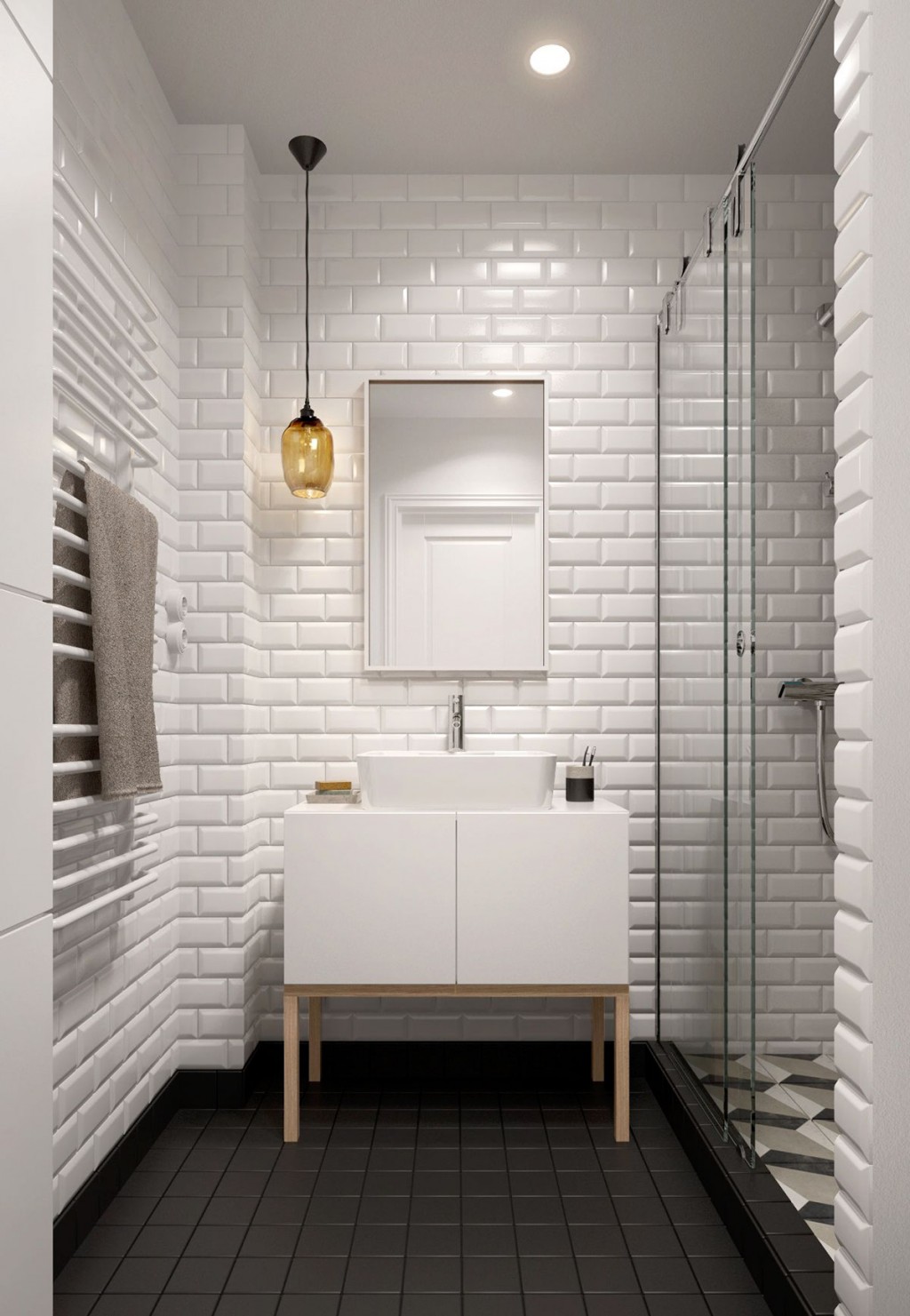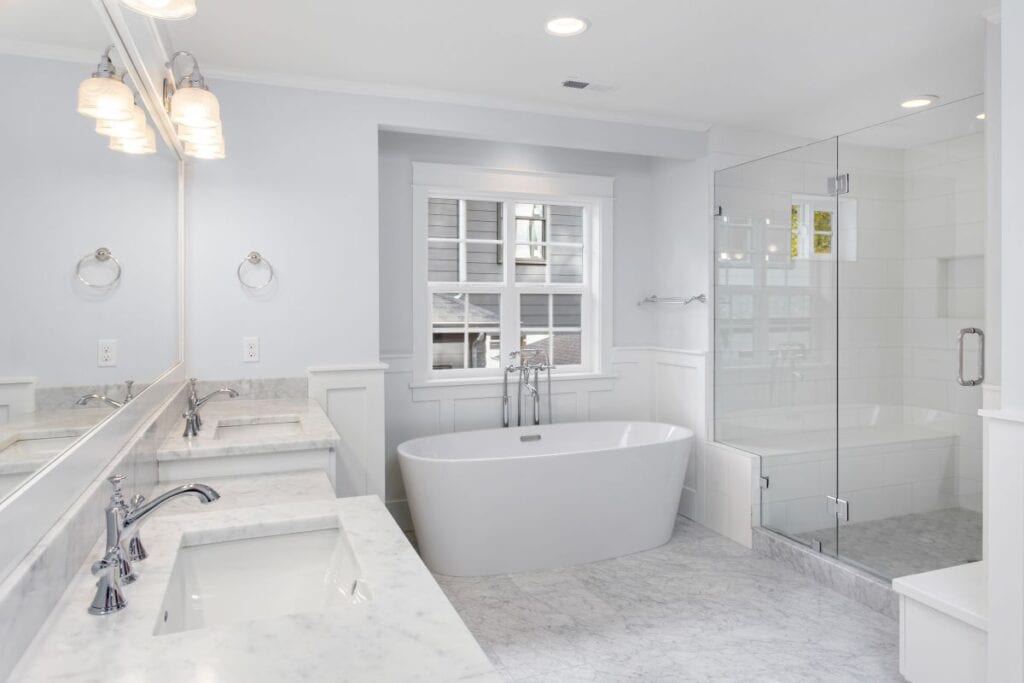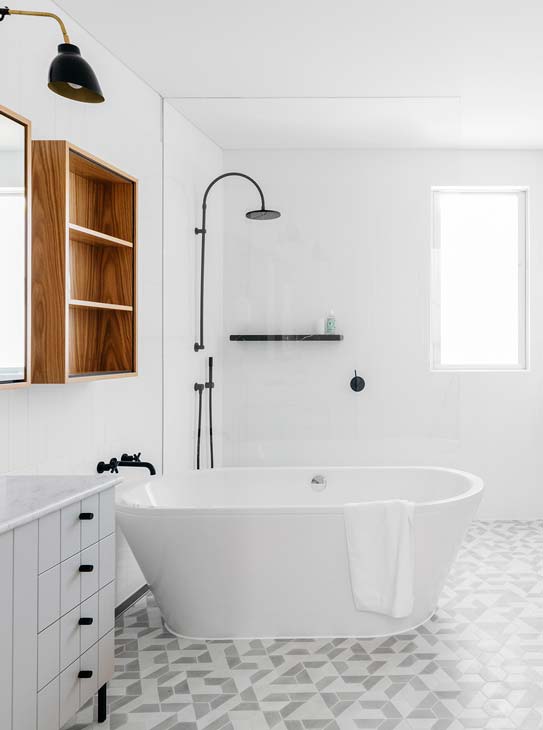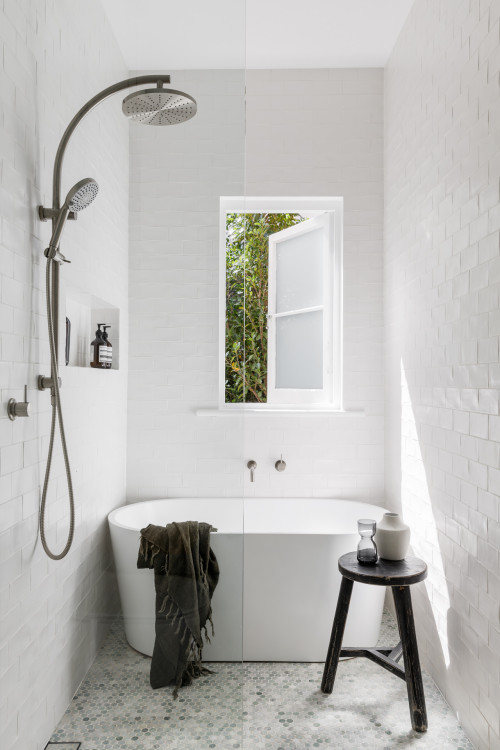Classic White Subway Tiles for a Timeless Look
White subway tiles have stood the test of time as a go-to option for bathroom walls and backsplashes. Their clean lines, versatility, and classic appeal make them ideal for almost any design style, from vintage to modern.
- The History Behind Subway Tiles
White subway tiles first became popular in the early 20th century, particularly in subway stations, which is how they got their name. Their sleek and glossy surface made them easy to clean, which was a priority in public spaces. Today, they maintain that same practical appeal, which is one reason why they continue to be a popular choice for bathrooms. - Versatility in Design
One of the greatest benefits of white subway tiles is their versatility. They can be arranged in various patterns to create different effects, from the traditional brick layout to more intricate herringbone or vertical arrangements. No matter how you place them, they maintain a timeless elegance that works well in a variety of bathroom styles. - Cost-Effective and Easy to Install
Subway tiles are often more affordable than other tiling options, making them a budget-friendly choice. Their uniform size and shape make them relatively easy to install, even for DIY enthusiasts. With proper grout and finishing, subway tiles can give your bathroom a polished, professional look without breaking the bank. - Low Maintenance and Durability
These tiles are also known for their low maintenance requirements. The smooth, glazed surface repels water and stains, making it easy to clean. A quick wipe with a damp cloth or mild cleaner is usually enough to keep them looking pristine. Plus, they are durable, resisting chips and cracks over time. - Adding Contrast with Grout
While white subway tiles are a classic choice, you can add a modern twist by using contrasting grout. Dark grout lines, such as charcoal or black, can highlight the geometric pattern of the tiles and give the bathroom a contemporary edge. Alternatively, white grout offers a seamless, minimalist look. - Elevating the Look with Accents
You can easily elevate the look of a subway-tiled bathroom by incorporating accent pieces like patterned floor tiles or decorative tile borders. This creates visual interest while allowing the subway tiles to remain the focal point of the design. Accent walls with subway tiles also work well, particularly behind vanities or bathtubs.

White Marble Tiles: Elegance Meets Durability
When it comes to luxury, white marble tiles are the epitome of elegance. Their natural veining, rich texture, and luxurious feel make them a popular choice for homeowners looking to create a sophisticated bathroom space.
Natural Beauty and Unique Patterns
Marble is a natural stone, which means each tile is unique. The veining in white marble tiles can range from subtle and soft to bold and dramatic, offering endless design possibilities. No two tiles are the same, which gives your bathroom a one-of-a-kind look that can’t be replicated with manufactured materials.
Timeless Elegance in Any Setting
White marble has been used for centuries in high-end architecture, from ancient Roman baths to modern luxury homes. Its classic beauty makes it a timeless choice for bathrooms, adding a sense of grandeur and refinement that few other materials can match. Whether you prefer a traditional or modern aesthetic, marble complements any design style.
Durability and Strength
Despite its delicate appearance, marble is a strong and durable material. When properly sealed, it can withstand the moisture and humidity of a bathroom environment. However, marble does require some upkeep to maintain its beauty, such as resealing every year to prevent staining and etching.
Different Types of White Marble
There are several varieties of white marble to choose from, each with its own distinct veining and coloring. Carrara marble, for example, is known for its soft gray veining, while Calacatta marble offers more dramatic, bold veining. Statuario marble, another popular option, combines both subtle and bold veining, making it a versatile choice for various design schemes.
Where to Use Marble Tiles in the Bathroom
White marble tiles can be used in various parts of the bathroom, including floors, walls, and shower surrounds. For a truly luxurious feel, consider using large-format marble tiles on the floor or as a feature wall behind the vanity or bathtub. Mosaic marble tiles can also be used for a more intricate, detailed look, especially in smaller areas like shower floors.
Maintaining Your Marble Tiles
Marble does require some care to keep it looking its best. Be mindful of acidic substances, such as lemon juice or vinegar, which can etch the surface. Using a pH-neutral cleaner specifically designed for stone will help preserve its beauty. Also, resealing marble regularly ensures that it remains resistant to water and staining.
Mixing Textures: Matte vs. Glossy White Tiles
Incorporating both matte and glossy white tiles into your bathroom design can add depth and interest to what might otherwise be a monochromatic space. Both finishes have their advantages, and mixing them creates a dynamic visual contrast.
The Appeal of Glossy Tiles
Glossy tiles are known for their reflective surface, which bounces light around the room and creates a bright, airy feel. They’re ideal for small bathrooms because they can make the space appear larger by reflecting both natural and artificial light. Glossy tiles are also easy to clean, making them a practical choice for areas prone to water splashes.
Subtle Sophistication with Matte Tiles
On the other hand, matte tiles offer a more subtle, understated look. Their non-reflective surface has a modern appeal and works well in bathrooms where you want to create a calm, serene atmosphere. Matte tiles also tend to hide water spots and smudges better than glossy tiles, making them a practical choice for high-traffic bathrooms.
Where to Use Glossy Tiles
Glossy tiles work best in areas where you want to maximize light. They are perfect for backsplashes, shower walls, and areas around windows where natural light can enhance their reflective qualities. In a predominantly white bathroom, glossy tiles on the walls can create a sense of openness and brightness.
Incorporating Matte Tiles in Design
Matte tiles, due to their more grounded appearance, are ideal for flooring and accent walls. Their slip-resistant surface makes them a safer choice for bathroom floors, especially in wet areas like showers. Matte tiles can also be used as an accent to create contrast with glossy tiles, adding texture and depth to the space.
Mixing Glossy and Matte for a Balanced Look
Combining both matte and glossy tiles is a great way to add visual interest to a white-tiled bathroom. For example, you could use glossy tiles on the walls and matte tiles on the floor, or create an accent wall with matte tiles in a herringbone pattern, while the rest of the bathroom features glossy tiles. The contrast between the two finishes adds a layer of sophistication without overwhelming the design.
Choosing the Right Lighting
When mixing matte and glossy tiles, consider the lighting in your bathroom. Glossy tiles reflect light, so placing them in well-lit areas can enhance their effect. Meanwhile, matte tiles work well in areas with softer lighting, as their non-reflective surface can create a warm, inviting atmosphere. The right combination of tiles and lighting can elevate your bathroom’s overall aesthetic.
White Mosaic Tiles for a Chic and Modern Bathroom
Mosaic tiles are a stylish way to add texture and pattern to your bathroom, and when done in white, they bring a modern, chic aesthetic. Their small size and intricate designs offer endless possibilities for creative bathroom layouts.
Versatility of Mosaic Tiles
White mosaic tiles are incredibly versatile, allowing for a variety of designs, from traditional to contemporary. Their small size makes them perfect for intricate patterns, and they can be used in different parts of the bathroom, from floors and walls to backsplashes and shower niches.
Creating Patterns and Designs
With white mosaic tiles, you can create stunning geometric patterns, such as hexagons, chevrons, or basketweaves. These patterns can add dimension and interest to an all-white bathroom while maintaining the clean, bright aesthetic that white tiles provide. Consider using a mosaic tile accent wall behind your vanity or bathtub to make a bold statement.
A Perfect Fit for Small Spaces
In small bathrooms, mosaic tiles can work wonders. The smaller size of the tiles helps make the space feel more intimate and detailed. You can use them in a compact shower stall, on the floor, or even on the ceiling for an unexpected design twist. The fine detailing of mosaic tiles helps to distract from the room’s size, making it feel more spacious.
Slip-Resistance and Functionality
Mosaic tiles, especially on bathroom floors, offer a practical advantage: their small size and numerous grout lines make them slip-resistant, an important factor in wet areas like showers. This makes them both a stylish and functional choice for bathrooms.
Pairing White Mosaics with Other Materials
White mosaic tiles pair beautifully with other materials such as marble, wood, or metallic accents. For instance, combining white mosaic tiles with a marble vanity top or wooden shelving adds contrast and warmth to the space, preventing it from feeling too sterile.
Easy to Clean and Maintain
Despite their intricate patterns, mosaic tiles are relatively easy to maintain. Regular cleaning with a gentle cleanser will keep them looking fresh, and the many grout lines provide added durability against wear and tear. Proper sealing of the grout can prevent staining, especially in high-traffic areas.
Geometric White Tiles: Adding Dimension to Your Space
Geometric tiles bring a modern edge to bathroom design, and when done in white, they offer a crisp, clean backdrop that can still pack a visual punch. Their shapes and patterns add depth and dimension to an otherwise simple design palette.
Why Geometric Tiles?
Geometric white tiles are an excellent way to add structure and form to your bathroom. Their shapes, whether hexagonal, triangular, or diamond, can make a significant design statement while maintaining the simplicity and elegance of a white tile.
Popular Geometric Shapes
Some of the most popular geometric shapes for bathroom tiles include hexagons, chevrons, and diamonds. These shapes can be arranged in various patterns to create different effects, such as a dynamic herringbone design or a classic honeycomb pattern. Geometric tiles can be used as a focal point in the bathroom, whether on the floor or as a feature wall.
Enhancing Space with Shapes
Geometric tiles can create an illusion of more space in smaller bathrooms. For example, elongated hexagonal tiles can make a small bathroom feel taller or wider, depending on how they are laid out. The clean lines of geometric tiles also give the bathroom a more organized, structured look.
Using White to Soften Bold Patterns
The white color of these tiles helps soften the sometimes-bold shapes of geometric designs. While the pattern adds interest, the neutral color keeps the design from overwhelming the space. This balance makes geometric white tiles ideal for those who want to experiment with pattern but prefer a minimalist color palette.
Geometric Tiles as an Accent
For a modern twist, use geometric white tiles as an accent rather than covering the entire bathroom. A geometric-tiled backsplash or shower wall can create a striking focal point without overpowering the room. Pairing these tiles with simpler white tiles or even matte finishes creates a visually layered look that is both contemporary and timeless.
Lighting and Texture
When choosing geometric tiles, lighting plays a key role in how the design is perceived. Natural or artificial light can highlight the tile’s shapes and shadows, enhancing their three-dimensional effect. Glossy finishes will reflect light, while matte finishes offer a more subdued look, allowing the geometry to take center stage without too much shine.
White Tiles with Colored Grout: A Creative Twist
If you’re looking for a way to personalize your bathroom with white tiles, using colored grout is a fun and creative option. The contrast between white tiles and colorful grout lines can completely transform the look of your bathroom, making it unique and tailored to your taste.
Why Choose Colored Grout?
Colored grout is a simple yet effective way to add character to white tiles. It allows you to introduce a pop of color without overwhelming the room. By playing with grout color, you can create contrast, enhance patterns, or even highlight certain features in the bathroom.
Popular Grout Colors
While white grout is the traditional choice for white tiles, experimenting with colors like black, gray, or even vibrant hues such as blue, green, or gold can bring out the best in your tile design. Black grout, for instance, offers a sharp contrast that emphasizes the shape of each tile, while gray provides a softer, more understated effect.
How Colored Grout Changes the Look
The color of the grout can change the overall feel of the bathroom. Dark grout tends to make white tiles appear more modern and graphic, while light-colored grout gives the bathroom a softer, more seamless appearance. Bright grout colors, such as teal or pink, can add a playful, unexpected element that makes the bathroom feel more personal and creative.
Maintenance Considerations
When using colored grout, keep in mind that darker grout colors tend to hide dirt and stains better than lighter ones. However, no matter the color, proper sealing of the grout is essential to prevent discoloration and ensure longevity. Regular cleaning will also help maintain the grout’s vibrancy and prevent it from fading over time.
Pairing with White Tiles
The beauty of using colored grout with white tiles is that it doesn’t detract from the clean, crisp look that white tiles bring. Instead, it enhances the design by adding depth and interest. The combination works well in both contemporary and traditional settings, making it a versatile option for bathrooms of all styles.
Using Grout to Highlight Patterns
If you’ve chosen a patterned tile, colored grout can help accentuate the design. For example, hexagonal tiles paired with dark grout create a bold, honeycomb effect, while a herringbone pattern with light-colored grout offers a more subtle, elegant look. The grout becomes part of the design, rather than just a functional element.
Incorporating White Tiles into Small Bathrooms for a Spacious Feel
White tiles are a popular choice for small bathrooms because of their ability to make spaces feel larger and more open. With the right design choices, you can maximize both the style and function of a small bathroom.
The Illusion of Space
White tiles are known for their ability to reflect light, which helps make small spaces feel brighter and more open. When used in small bathrooms, white tiles can visually expand the room, making it feel less cramped. This effect is especially powerful when paired with ample lighting and mirrors.
Choosing the Right Tile Size
In small bathrooms, tile size can have a big impact on the overall look and feel of the space. Large-format white tiles, for example, create fewer grout lines, which can help reduce visual clutter and make the room feel more expansive. On the other hand, small tiles, such as mosaics, can add texture and interest without overwhelming the space.
Glossy vs. Matte Finishes
Glossy white tiles are often the go-to choice for small bathrooms because their reflective surface helps bounce light around the room, making it feel brighter. However, matte tiles can also work in small spaces, especially if you want to create a more muted, spa-like atmosphere. Both finishes can be used effectively, depending on the overall design of the bathroom.
Using White Tiles on Walls and Floors
To maximize the spacious feel of a small bathroom, consider using white tiles on both the walls and the floor. This creates a seamless, cohesive look that draws the eye upward and gives the illusion of height. You can also use white tiles to cover the shower area, creating a unified look that visually expands the space.
Incorporating Accents and Contrasts
While white tiles can make a small bathroom feel larger, incorporating a few accent elements can prevent the space from feeling too sterile. Adding a feature wall with textured white tiles, such as a herringbone or hexagonal pattern, creates visual interest without sacrificing the spacious feel. Additionally, contrasting elements like black fixtures or natural wood accents can add warmth and character to the room.
The Role of Lighting in Small Bathrooms
Lighting plays a crucial role in enhancing the effect of white tiles in small bathrooms. Proper lighting, whether natural or artificial, can highlight the reflective qualities of glossy white tiles and create a bright, inviting atmosphere. Mirrors placed strategically across from windows or light sources can also amplify the light and further expand the sense of space.
Essential Bathroom Tile Design Ideas
Bathroom Tile Ideas – Bath Tile Backsplash and Floor Designs
White Tile Bathroom Ideas You’ll Love
White Bathroom (TIMELESS LOOK) – Clean and Fresh Bathrooms
Related Posts:








